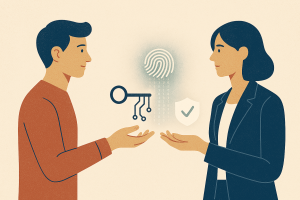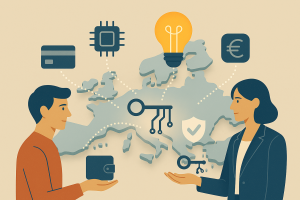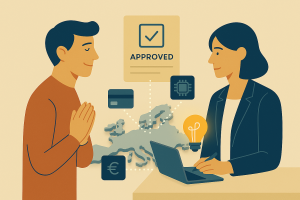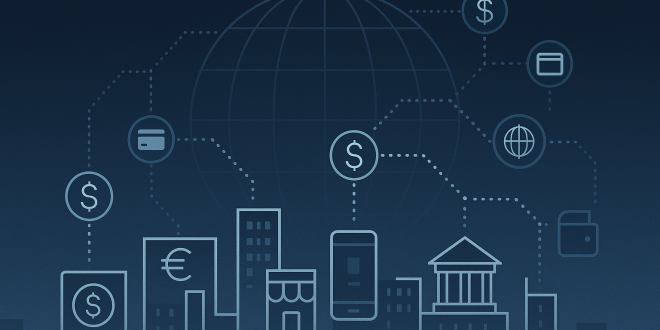By Ivan Arnaudov, CEO of Access Finance Inc
Many Americans are enduring a credit crisis, and part of the reason is the slow adoption of open banking in the US. Unlike in Europe, where open banking has already transformed access to financial services, the US is still playing catch-up.
Open banking – consumer permissioned sharing of their financial data using APIs among banks, fintechs and other financial institutions – has the power to enable consumers with poor or no credit to access vital financial products and provide a pathway to improving their overall financial health.
The US is making progress toward wider adoption of open banking, but speed matters because consumers are already paying the price today.
Why Consumers Need Open Banking
A shocking percentage of Americans struggle with access to credit, most often due to their credit rating. Credit has gotten harder to obtain. A recent Bankrate survey found nearly half (48%) of all Americans who have applied for a loan or financial product since December 2023 have been rejected.

Some Americans are also digging themselves into deeper credit holes by missing or failing to make payments for a variety of reasons that include confusion over the status of their debt, poor communication with the debt servicers or outdated contact information, according to a Wall Street Journal article on student loan borrowers. The hit to their credit ratings exacerbates the problem and has a ripple effect that leads to higher loan payments or the denial of credit altogether for future borrowing, such as mortgages.
Open Banking Already Driving Innovation in Europe
Open banking is reshaping Europe’s financial industry by enabling new business models for fintech startups and forcing traditional banks to innovate. Fintech companies can securely access bank data (with user consent) to build services like personal finance apps, payment initiators, and Banking-as-a-Service platforms.
Banks that embrace open APIs can partner with these fintechs or offer expanded services, creating new revenue streams instead of losing customers. A 2022 survey of global financial institutions found that 99% consider open banking a “must-have” or essential feature for banks, highlighting its importance for future competitiveness.
Incumbent banks that leverage open banking can improve customer retention and cross-selling, while those slow to adapt face increased pressure from more agile entrants.
For consumers and small businesses, open banking promises more choices and personalized services. With consent, users can aggregate accounts from multiple banks into one app, gain real-time financial insights, and access tailored product recommendations.

This greater transparency and control help customers find better loan rates, manage spending, or switch providers more easily. Open banking has lowered barriers to entry in finance, allowing tech firms and even retailers to offer financial services.
The result is a more competitive market with innovative offerings (such as budgeting tools, smart lending platforms, and account-to-account payment options) that challenge traditional banking products. Overall, the European market is seeing improved financial inclusion.
For example, previously “unbanked” or underserved customers can use new fintech services based on open data, and SMEs (small and medium enterprises) get easier access to financing. As one industry expert noted, open banking “affords greater flexibility in how money is managed” for customers, fundamentally changing the idea of banking itself.
Open Banking Transforming Credit Underwriting
Open banking is revolutionizing how lenders assess creditworthiness by providing direct access to applicants’ financial data (with permission). Traditionally, banks relied on credit bureau scores and static documents for underwriting, which often lacked nuance, especially for thin-file borrowers or small businesses. Now, with customers’ transaction histories and account data available via APIs, lenders can perform a more granular analysis of income patterns, expenses, and cash flows.
In the UK (a leader in open banking usage), regulators have observed that open banking is one of the main drivers of innovation in the credit information market. By analyzing bank account data, lenders can better evaluate affordability and verify income/employment in real time rather than relying solely on credit scores.

This real-time insight means that credit decisions can be faster and more accurate. It also helps include borrowers who might be “credit invisible” under old models – for example, young people or gig-economy workers with scant credit history can share banking data to demonstrate their financial behavior.
These supplementary data sources can help the estimated 106 million US consumers who are “un-scoreable, invisible or subprime” build credit files and enable fairer lending decisions. Several fintech lenders and credit bureaus in Europe (eg, Experian Boost, Credit Kudos before its acquisition, etc) use open banking data to enhance scoring models, often improving approval rates for good borrowers who might have been declined under traditional methods. In short, open banking is making underwriting more inclusive and data-driven while reducing reliance on outdated credit models.
At Access Finance, we’ve already seen how Open Banking has helped our customers in Europe make financial services more accessible, competitive, and tailored to individual needs.
In Poland, we’ve found that access to Open Banking data increases the maximum allowable credit limit for new customers by 12% compared to those without Open Banking data. It’s also enabled us to extend credit to customers. Without Open Banking, we would be forced to reject 20% of the activated cards each month, relying solely on traditional credit bureau data.
Our data from Spain shows that customers who have access to Open Banking have a 9% higher chance of approval, and their initial credit limits are, on average, 19% higher than those of customers who do not use Open Banking. Furthermore, these customers receive an instant decision, whereas other customers must undergo a more complex process, including providing income documentation and waiting for verification.
The US Can’t Afford to Wait
Open banking can transform the financial landscape in the US, just as it has already done around the world. Increasing competition and reducing fees can lower banking costs for consumers. It can improve access to credit through alternative, data-driven lending, provide consumers with better financial insights, and enhance security by reducing the reliance on outdated methods.
To realize these benefits, continued momentum is needed. Regulators need to finalize a secure open banking framework, and financial institutions need to embrace new data-driven models for underwriting. Getting this right will lead to a fairer, more inclusive financial system.
About the Author

Ivan Arnaudov is the CEO of Access Finance Inc, a digital credit provider focused on building more inclusive and accessible financial products for underserved consumers. With over two decades of experience in fintech, BPO, IT, and marketing technology, Ivan brings deep expertise in digital cards, credit infrastructure, and growth strategy. He also serves as Chief Strategy Officer at Access Finance AD, where he leads the company’s international expansion and product innovation efforts across Europe and the US.
Recent PaymentsNEXT news:
What the 2025 Chargeback Surge Means for Banks and Merchants

